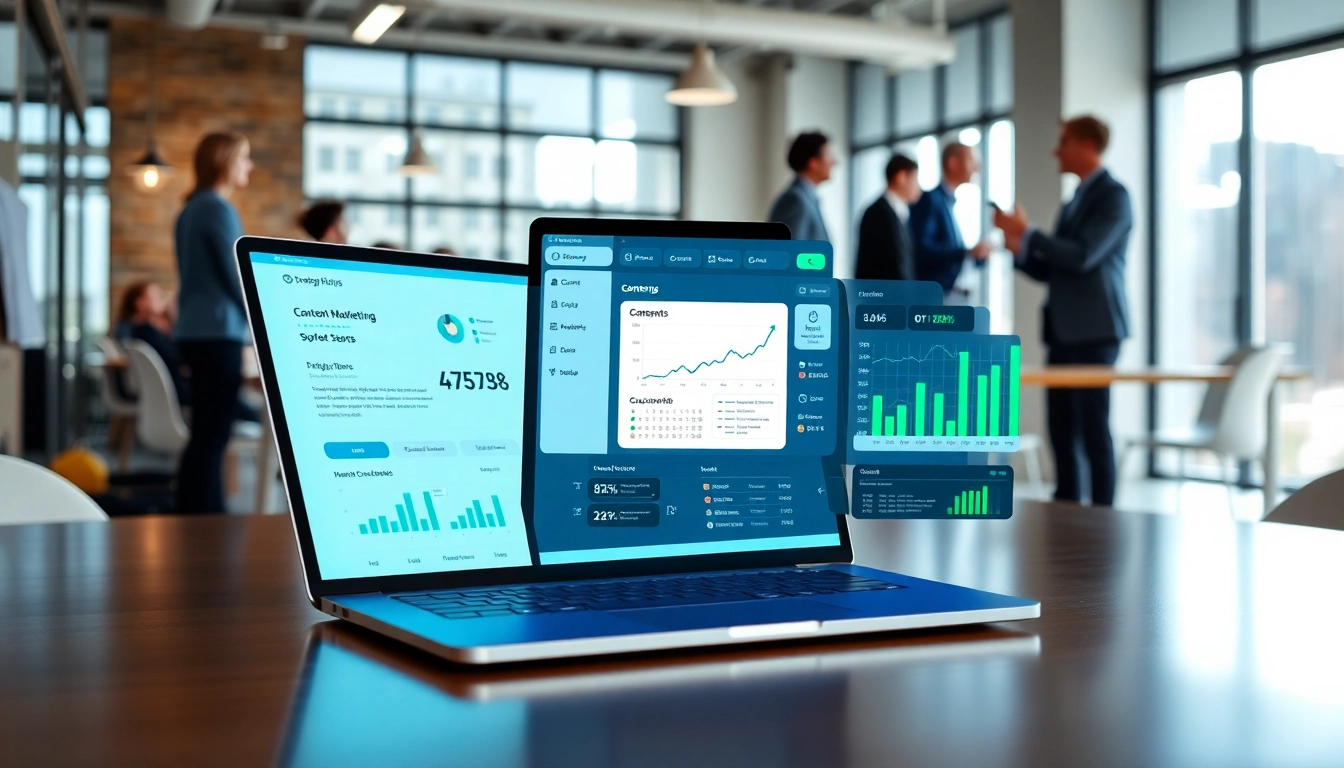Understanding AI for Competitive Intelligence
In today’s fast-paced business environment, staying ahead of the competition is crucial for success. Companies are increasingly turning to ai for competitive intelligence to gain insights that can inform their strategy and tactics. This article delves into the nuances of how AI shapes competitive intelligence, the advantages it offers, common misconceptions, and its transformative role in evolving business practices.
What is AI and Its Role in Competitive Intelligence?
Artificial Intelligence (AI) encompasses a variety of technologies that enable machines to perform tasks traditionally requiring human intelligence. These tasks include learning, reasoning, problem-solving, perception, and language understanding. In the realm of competitive intelligence, AI plays a pivotal role in analyzing vast amounts of data from various sources, enabling businesses to glean actionable insights more efficiently.
AI’s capability to automate data analysis and reporting processes allows organizations to go beyond simple data collection. By employing machine learning algorithms and natural language processing, AI can identify patterns, trends, and anomalies in competitor behavior, revealing opportunities for business growth or potential threats. This allows companies not only to react proactively but also to forecast future competitive movements.
Key Benefits of AI for Competitive Intelligence
The integration of AI into competitive intelligence programs offers numerous advantages:
- Enhanced Data Processing: AI can process vast amounts of data in real-time, vastly improving decision-making speed and accuracy.
- Actionable Insights: By analyzing data trends, AI can provide insights that are directly applicable to business strategies, helping leaders to make informed decisions.
- Cost Efficiency: Automating data collection and analysis tasks reduces the time and resources required for comprehensive competitive assessments.
- Predictive Analytics: AI’s machine learning capabilities allow businesses to forecast competitor actions, market shifts, and consumer behavior trends.
Common Misconceptions About AI in Competitive Analysis
Despite the many benefits, several misconceptions about AI in competitive analysis persist:
- AI Replaces Human Analysts: While AI enhances data analysis, human judgment is essential for context, intuition, and ethical considerations.
- AI is Only for Large Enterprises: Many AI tools are accessible to businesses of all sizes, offering scalable solutions tailored to different organizational needs.
- AI Can Do Everything: AI excels at pattern recognition and data processing but may struggle with subjective insights that require human empathy and understanding.
How AI Improves Data Collection Methods
Automating Data Gathering from Multiple Sources
One of the greatest challenges in competitive intelligence is obtaining relevant, up-to-date information across diverse sources. AI automates data gathering by using web scrapers and API connectors to pull data from social media, news articles, company websites, and more. This efficiency ensures that businesses have access to the latest intelligence without the tedium of manual collection.
For example, platforms like Crayon utilize machine learning to monitor competitor activity, delivering real-time data back to users, which helps organizations stay informed about industry changes as they happen.
Enhancing Data Accuracy and Relevance
AI algorithms help filter noise from valuable information. They are capable of assessing the context and relevance of data, ensuring that what reaches analysts is accurate and meaningful. Techniques such as sentiment analysis can help establish the tone and impact of competitor communications, while natural language processing can extract key metrics from textual data.
For instance, AI can analyze social media sentiment around a competitor’s product launch, providing insights into consumer perception and potential market reception that traditional methods might overlook.
Integrating AI Tools for Streamlined Processes
Integrating various AI tools can create a robust competitive intelligence framework. Solutions like WatchMyCompetitor curate actionable insights that further enhance competitive analysis processes. These tools can integrate with existing CRMs, marketing platforms, and data analytics software to provide a comprehensive view of market positioning.
Such integration minimizes data silos within organizations, ensuring all relevant departments can operate with a shared understanding of the competitive landscape.
Data Analysis Techniques with AI
Leveraging Machine Learning for Insight Extraction
Machine learning algorithms can sift through complex data sets to extract insights that might be missed through conventional methods. These algorithms learn from historical data, enabling them to adapt to changing market conditions and uncover hidden patterns that shape competitive strategy.
For example, machine learning can be utilized for clustering competitors based on similar strategies or to identify outliers that represent emerging threats or disruptive innovators in the market.
Visualizing Complex Data with AI Tools
AI doesn’t just help analyze data; it also aids in visualizing complex data sets in a comprehensible manner. Tools that leverage AI for visualization can create intuitive dashboards that highlight key performance indicators, trends, and predictions. This visual representation aids stakeholders in making informed decisions quickly.
Platforms such as Kompyte provide visual analysis of market and competitor data, helping teams understand competitive dynamics at a glance.
Case Studies: Successful Implementation of AI Analysis
Numerous organizations have reported substantial improvements in their competitive intelligence activities through the implementation of AI. For instance:
- Retail Sector: A retail chain implemented AI tools to analyze competitor prices and promotions, enabling them to adjust their strategies dynamically. As a result, they increased market share by 15% within a year.
- Technology Companies: A software company leveraged AI to monitor competitor product launches, capturing user sentiments in real-time. This facilitated timely adjustments in their marketing approach, resulting in a successful product introduction.
Challenges in Implementing AI for Competitive Intelligence
Addressing Data Privacy and Compliance
With the increasing use of AI in data collection and analysis, concerns regarding data privacy and compliance have emerged. Organizations must navigate complex regulations such as GDPR and CCPA while ensuring that their data gathering practices are ethical and legal.
To address these challenges, companies should implement stringent data governance frameworks that outline how data is collected, managed, and utilized.
Overcoming Resistance to Technological Change
Introducing AI into competitive intelligence practices can be met with skepticism from employees accustomed to traditional methods. To overcome resistance, leaders should foster a culture of innovation and emphasize the benefits of AI tools in enhancing their work rather than replacing it.
Offering training sessions and workshops can also help staff become familiar with new tools, illustrating how AI complements their current skill sets.
Ensuring Data Quality and Relevance
AI’s effectiveness is contingent upon the quality of the data fed into it. Poor-quality data can lead to inaccurate insights. Businesses should prioritize data hygiene, employing validation processes to ensure all data is accurate, current, and relevant.
Employing a combination of automated data-collection solutions with human oversight can strike a balance between efficiency and accuracy.
Future Trends in AI and Competitive Intelligence
Emerging Technologies to Watch
As AI technology continues to evolve, several trends are predicted to shape the future of competitive intelligence:
- Natural Language Processing: Enhanced NLP capabilities will allow AI to better understand human nuances, improving its ability to analyze open-ended responses and competitive sentiment.
- Automated Predictive Analytics: Future tools will likely employ advanced algorithms that automate predictive analytics, offering businesses more accurate forecasts and insights.
- Integration of AI with IoT Data: As Internet of Things (IoT) devices proliferate, analyzing the data they generate could offer critical insights into consumer behavior and preferences.
Preparing Your Business for AI Innovations
Organizations must be proactive in preparing for AI innovations by investing in talent development, infrastructure, and technologies that support AI integration. This might involve upskilling existing employees or hiring data scientists and AI specialists to build a more robust team.
Being proactive about addressing ethical considerations in AI use will also be crucial in maintaining consumer trust.
Building a Culture of Continuous Improvement
A healthy organizational culture that embraces continuous improvement and innovation is crucial for successful AI implementation. Companies should adopt a mindset of agility, encouraging teams to experiment with AI tools and learn from failure. This culture fosters resilience and encourages adaptability in an ever-changing competitive landscape.


